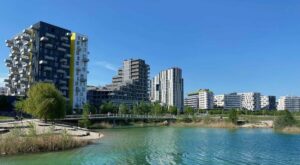While preparing for my first trip to the Azores, I expected to find myself in the untouched wilderness with no people and no infrastructure. My plan was to hike, camp, and enjoy the solitude only a far-flung place can provide. As I was to find out, since the appearance of low-cost flights the volcanic archipelago ceased to be a truly “under-discovered” destination.
The Azores remain, however, a wonderful spot for a comfortable and healing get-away from urban sprawl.
The Azores, a family of islands located in the North of the Atlantic Ocean, are one of Portugal’s greatest natural treasures. Formed by volcanic eruptions over time, the archipelago is made up of nine islands — São Miguel, Terceira, Flores, Corvo, Graciosa, São Jorge, Pico, Faial, and Santa Maria — each one with its own identity.
While paying a visit to all of them would take several weeks (and several flights since the area extends for more than 600 kilometers), here I share some ideas on how to concentrate on the most reachable and diverse highlights.
When and how to travel
The most important thing to know before packing your luggage is the Azorean weather. You have to be prepared for showers and strong sun alike. The climate of the Azores, while being mild for such a northern location, is still rather fresh, humid and inconstant, prompt to switch on and off between sunshine, fog, and rain.
The moody weather is compensated with the year-long lush greenery of ancient forests and the gorgeous blooming of hortensias and camellias. Moreover, in the warmer months (from mid-May to mid-October), the weather tends to be smooth, making the Azores a great summer destination for those who want to escape the heat.
In fact, some of my friends who work remotely enjoy staying on one of the islands for a couple of months around early autumn, renting a house right on the coast and harvesting all the best days to explore the natural sights.
Most direct international flights will take you to the main hubs — São Miguel and Terceira – making the two the best places to start and end your journey. In order to get to smaller islands, use a local airline, Azores Airlines, previously known as SATA.
Booking more than one inter-island flight as a multi-city trip can save a significant amount of money. To move between the closely-located islands — for instance, Pico and Faial — use ferries.

Which islands to choose for a full Azorian experience?
São Miguel: Grand island of the archipelago
São Miguel is the grand island of the archipelago. The most visited island of all, São Miguel is a great start to figuring out what the Azores are all about. It also offers more services and more accommodation facilities for tourists.
Volcanic lakes, pineapple and tea plantations, hot springs in the middle of pristine woods and a number of outstanding restaurants make it an ideal choice if your time is limited or if you don’t feel like hopping from one island to another. That being said, however, I strongly advise you to continue your travel and visit the islands more off the beaten track.
Faial: Geological wonders
The lunar landscape of the Capelinhos volcano on the western tip of Faial is one-of-a-kind in all Azores. The last eruption that occurred 50 years ago covered the area with a thick layer of ash turning it into a desert. Amid this extraterrestrial landscape, the Lighthouse of Ponta dos Capelinhos was left standing and remains an iconic site to visit and take pictures.

Pico: Marine life and volcano climb
Pico is not just an island but also, at 2,351, the highest mountain in Portugal and a pretty doable climb with stunning views. The official website of the Pico Mountain Natural Reserve that controls the access to the peak suggests reserving an average duration of three-to-four hours for each ascent and descent but we took half of that time for a return-trip.
Once back from the clouds on the top of the volcano, book a boat trip along the coast to spot dolphins, turtles and whales. Even though spotting a whale is never guaranteed, we were extremely lucky right away!
São Jorge: coffee and surfing
Surprisingly, São Jorge, an island famous for its endemic vegetation and countless dragon trees, recently became a popular surfing spot. Bigger than the neighboring Faial and Pico, São Jorge calls for a prolonged summer stay with various sea activities, hikes and … coffee tasting.
The northernmost coffee farm in the world occupies steep flatlands at sea level called fajãs and is incredibly picturesque. And the coffee is really good too!
Terceira: colorful Angra do Heroismo and easy hikes
Terceira works really well as a final stop of your island hopping. Take a couple of days to enjoy hiking the multiple routes (they can be found on VisitAzores app) across the island and take every opportunity to have a swim.
The main city of Terceira, Angra do Heroismo, is a charming UNESCO-recognized town with well-preserved colorful architecture and a stunning Duque da Terceira garden right in its center.
The Azores is a truly therapeutic place that, if visited once, is being dreamed of again and again, right as I do now after having written this little guide — and rightfully so, as there is always a new island, a new panoramic view, or a new volcanic lake to discover.
––––––––––
Read more about Portugal here in Dispatches’ archives.
Nina Danilova is an art writer and contemporary art curator. She is about to finish her PhD
in Culture Studies. She grew up in Russia and lived in Germany, Estonia, Italy and
Portugal, where she is currently based. She is passionate about history, languages, food,
and dancing.















